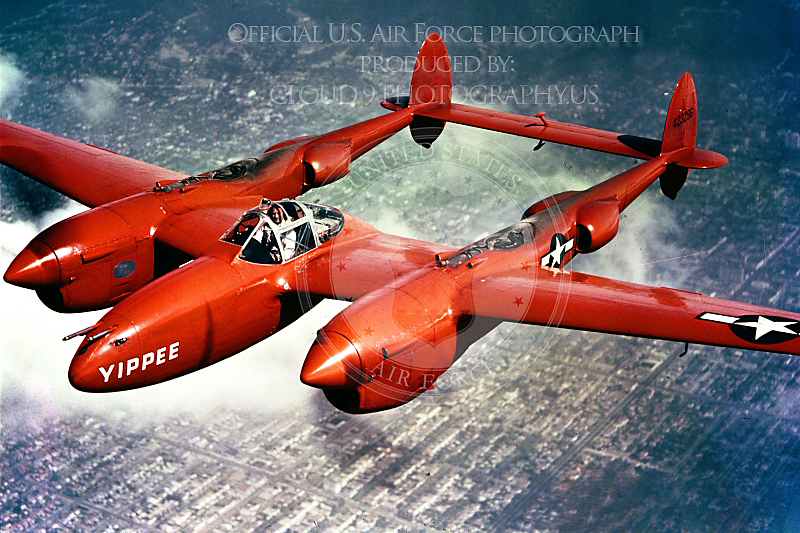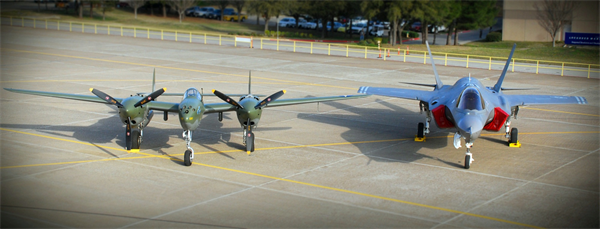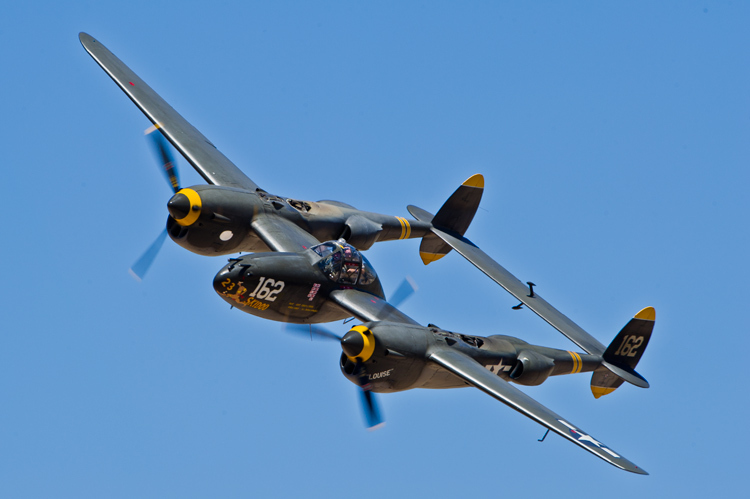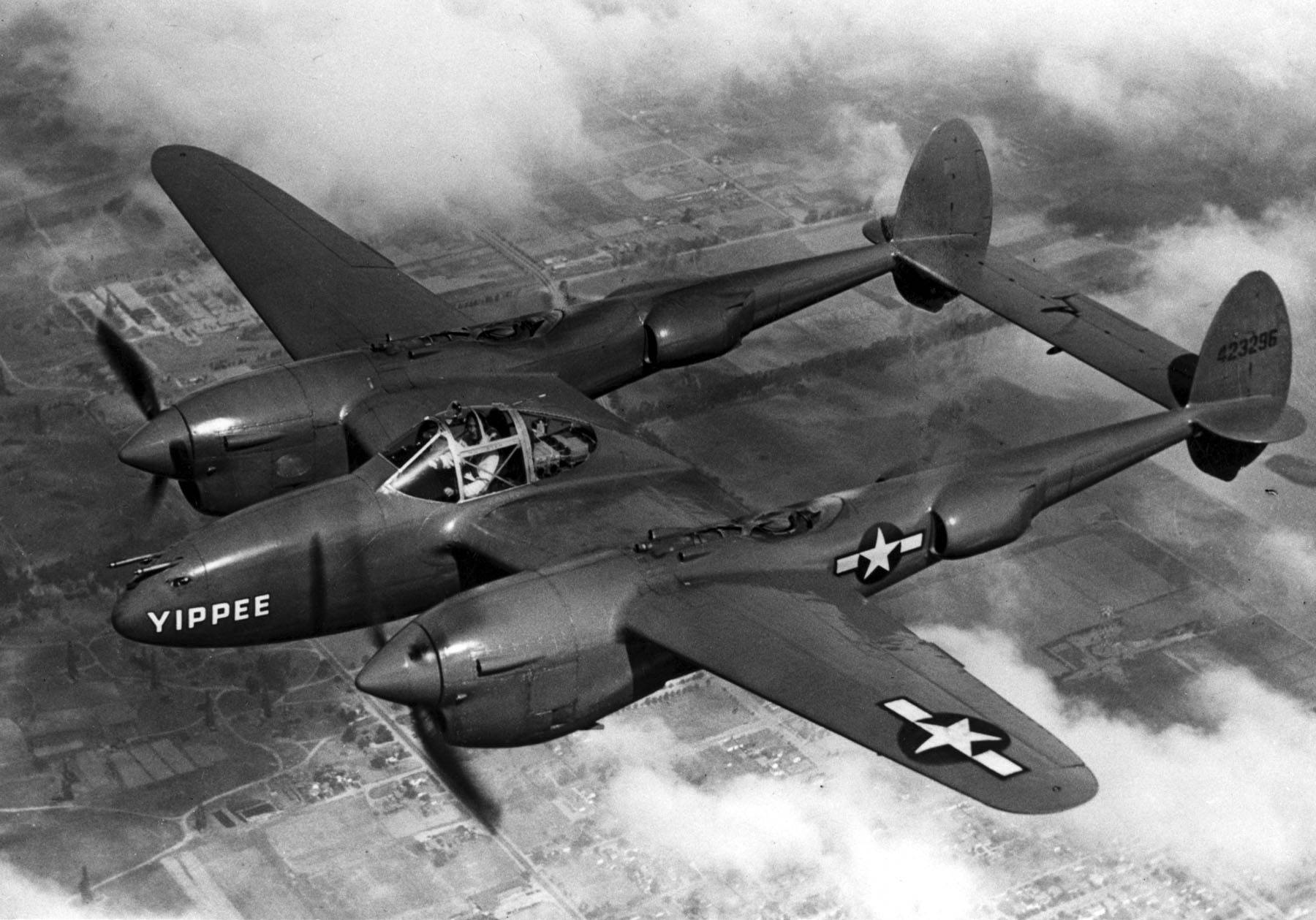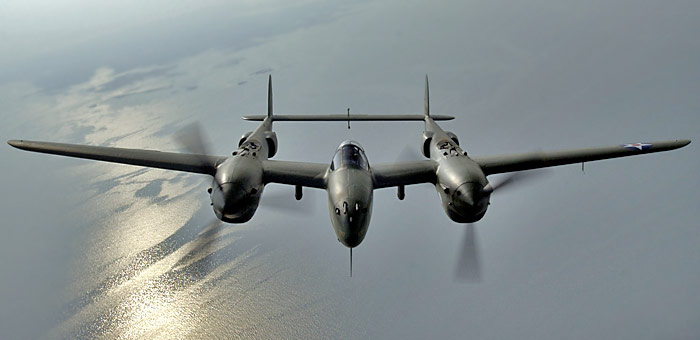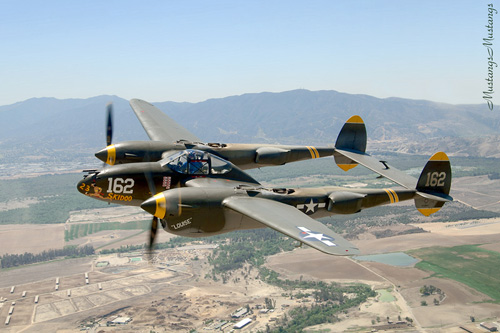
We also need to include the P38 lightening amongst the best fighters of that era for example:
The P-38 Lightning introduced a new dimension to American fighters—a second engine. The multi-engine configuration reduced the Lightning loss-rate to anti-aircraft gunfire during ground attack missions. Single-engine airplanes equipped with power plants cooled by pressurized liquid, such as the North American P-51 Mustang, were particularly vulnerable. Even a small nick in one coolant line could cause the engine to seize in a matter of minutes.
The P-38 Lightning designed by Lockheed engineer Clarence "Kelly" Johnson and his team of designers represented one of the most radical departures from tradition in American fighter development. The Lightning was a complete break from conventional airframe design, power and armament. Not only did it have twice the power and almost twice the size of its predecessors, but with no less than four .50 caliber machine guns plus a 20 mm cannon, the P-38 had enough firepower to sink a ship—and sometimes did. Located in the central fuselage pod, the guns fired parallel which eliminated a need for propeller synchronization.
The Lightning tricycle landing gear and twin-boom configuration completed the list of major deviations from what might he considered conventional Army fighters. In this respect, it was very unusual that the Lightning design progressed beyond the testing stage; such radical concepts seldom achieved production status. But the simple fact was that the P-38 design worked and the Army seemed to have found its dream plane in this 400 mph fighter.
The XP-38, 37-457, was built under tight secrecy and made its maiden flight on January 27, 1939 with Air Corps test pilot and P-38 project officer, Lt. Benjamin S. Kelsey at the controls. The P-38's performance justified Lockheed's investment of nearly $6,000,000 of its own funds to complete the prototype. The Army was so delighted with the big new fighter, it lifted the wraps of secrecy from the plane for a transcontinental speed dash on February 11, 1939. This event was marred by a crash when Kelsey undershot the runway at Mitchell Field, NY. Kelsey survived the crash and remained an important part of the Lightning program. The airplane was written off, but Lockheed received a contract for thirteen YP-38s along with the usual list of improvements.
The XP-38 had been powered by two liquid cooled, Allison V-1710 engines turning 11 ½ foot Curtiss Electric, inward turning, counter-rotating propellers. With the YP-38s and all subsequent Lightings, the propellers rotated outward negating torque when both engines were operating (A batch ordered by Britain did not have counter-rotating propellers.) One XP-38A was built with a pressurized cabin. Armament on the YPs was altered by replacement of two of the .50s with .30s, and the 20 mm cannon gave way to a 37 mm. But even before the YP-38s were completed, the original machine gun arrangement was standardized for production types. The first production order was 35 P-38Ds, followed by 210 P-3XEs which reverted back to the 20 mm cannon. These planes began to arrive in October 1941 just before America entered World War II. With the P-38D came self sealing fuel tanks and armor protection for the pilot. The Lightning was ready for war!
With World War II raging in Europe, Lockheed received an order for 667 P-38s from Britain and France in early 1940. The entirety of the order was assumed by the British following France's defeat in May. Designating the aircraft the Lightning I, the British name took hold and became common usage among Allied forces. The P-38 entered service in 1941, with the US 1st Fighter Group. With the US entry into the war, P-38s were deployed to the West Coast to defend against an anticipated Japanese attack. The first to see frontline duty were F-4 photo reconnaissance aircraft which operated from Australia in April 1942.
The next month, P-38s were sent to the Aleutian Islands where the aircraft's long range made it ideal for dealing with Japanese activities in the area. On August 9, the P-38 scored its first kills of the war when the 343rd Fighter Group downed a pair of Japanese Kawanishi H6K flying boats. Through the middle of 1942, the majority of P-38 squadrons were sent to Britain as part of the Operation Bolero. Others were sent to North Africa, where they aided the Allies in gaining control of skies over the Mediterranean. Recognizing the aircraft as a formidable opponent, the Germans named the P-38 the "Fork-Tailed Devil."
Back in Britain, the P-38 was again utilized for its long range and it saw extensive service as a bomber escort. Despite a good combat record, the P-38 was plagued with engine issues largely due to the lower quality of European fuels. While this was resolved with the introduction of the P-38J, many fighter groups were transitioned to the new P-51 Mustang by late 1944. In the Pacific, the P-38 saw extensive service for the duration of the war and downed more Japanese aircraft than any other US Army Air Force fighter.
Though not as maneuverable as the Japanese A6M Zero, the P-38's power and speed allowed it to fight on its own terms. The aircraft also benefited from having its armament mounted in the nose. Unlike fighters with wing-mounted guns, the P-38 did not need to set its guns to converge at a given range. This meant that P-38 pilots could engage targets at a longer range, sometimes avoiding the need to close with Japanese aircraft. Noted US ace Major Dick Bong frequently chose to down enemy planes in this fashion, relying on the longer range of his weapons.
On April 18, 1943, the aircraft flew one of its most famous missions when 16 P-38Gs were dispatched from Guadalcanal to intercept a transport carrying the Commander-in-Chief of the Japanese Combined Fleet, Admiral Isoroku Yamamoto, near Bougainville. Skimming the waves to avoid detection, the P-38s succeeded in downing the admiral's plane as well as three others. By the end of the war, the P-38 had downed over 1,800 Japanese aircraft, with over 100 pilots becoming aces in the process.
A major problem surfaced with the loss of control in a dive caused by aerodynamic compressibility. During late spring 1941, Air Corps Major Signa A. Gilke encountered serious trouble while diving his Lightning at high-speed from an altitude of 30,000 ft (9,120 m). When the airplane reached an indicated airspeed of about 320 mph (515 kph), the airplane's tail began to shake violently and the nose dropped until the dive was almost vertical. Signa recovered and landed safely and the tail buffet problem was soon resolved after Lockheed installed new fillets to improve airflow where the cockpit gondola joined the wing center section. Seventeen months passed before engineers began to determine what caused the Lightning's nose to drop. They tested a scale model P-38 in the Ames Laboratory wind tunnel operated by the NACA (National Advisory Committee for Aeronautics) and found that shock waves formed over the wing when the airflow reached transonic speeds cusing turbulence. Lockheed never remedied this problem, but the firm did install dive recovery flaps under each wing in 1944 to restore lift and smooth the airflow enough to maintain control when diving at high-speed.
The fastest of the Lightnings was the P-38J with a top speed of 420 mph, and the version produced in the greatest quantity was the "L", of which 3,735 were built by Lockheed and 113 by Vultee. The P-38L was powered by two 1,475 hp Allison V1710-111 engines. As with any long-term production aircraft, the P-38 underwent many modifications. The P-38J intakes under the engines were enlarged to house core-type intercoolers. The curved windscreen was replaced by a flat panel, and the boom mounted radiators were enlarged. Some were fitted with bombardier type noses, and were used to lead formations of bomb-laden P-38s to their targets. The P-38M was a two-seat radar-equipped night fighter, a few of which had become operational before the war ended. One interesting variation had an elevated tail assembly on upswept booms; another one had an elongated center pod and was used for airfoil evaluation.
The dimensions of the P-38 remained the same throughout production, its wing spanning 52 feet with an area of 328 square feet. The overall length was 37 feet 10 inches; height was 12 feet 10 inches. The P-38L weighed 12,800 pounds empty and 17,500 pounds gross. Thus, the P-38 was the largest, heaviest, and fastest "P" type to date. An internal fuel capacity of 410 gallons could be increased to 1,010 gallons with two external drop tanks and gave the Lightning a range of 450 miles, making it the first fighter suitable as a long-range bomber escort. In addition to its devastating nose armament, the P-38 could carry up to 4,000 pounds of external weapons including bombs and rockets.
Did it have problems? Yes, and so did the other fighters but, to forget about this beauty of a fighter would be - well, hollow in covering all of the best world War II fighters of yesterday.


Respectfully to most,
Henry

 (oh, and while I don't use them profusely, I like the emoticoms. They at least help a little in places to explain our 'tone' if not overused).
(oh, and while I don't use them profusely, I like the emoticoms. They at least help a little in places to explain our 'tone' if not overused).
 )
)








